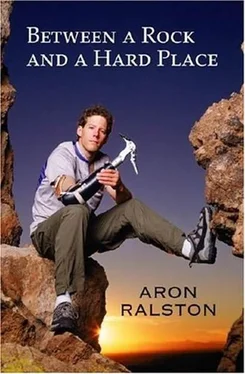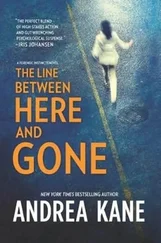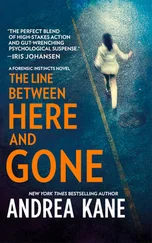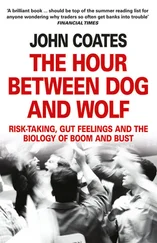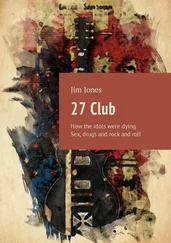It’s going on eight o’clock, and a breeze is blowing softly downcanyon. Every few minutes, the wind accelerates, flicking sand over the ledge above me into my face. I bow my head to protect my face beneath the brim of my hat. This keeps most of the dust out of my eyes, but I can feel the grit on my contacts. After huddling from a half-dozen cycles of the breeze, I catch myself not doing anything or even thinking about anything; I’m in a fleeting daze that dissolves when I become aware of it. Coming back around to my current situation, I look at the broken-up dirt and rock pieces covering my right arm. Using my fingers, then my knife, to get to the more confined spots around my right hand, I brush off the dirt. With pursed lips, I puff the last dust particles off my hand. It’s ridiculous, this compulsion to keep my arm clean, but being tidy is one of the few means by which I can exert even a small degree of control over my circumstances.
I resume my excavation as darkness seeps from my penumbral hole and spills into the desert above me, turning dusk to night. I turn my headlamp back on and pick a new target on the chockstone-a beige-pink heart of sandstone ringed by hard black mineral features. This spot is two inches above my wrist, so I am cautious with my strikes until I can chisel out a starter hole that allows me to jab harder at the chockstone. I establish a rhythm, pecking at two jabs per second, pausing to blow away dust once every five minutes. Time slips past. I can see a tiny measure of progress as a small salmon-colored flake emerges beside the shallow trough I’m carving out of the chockstone. If I’m right, I might be able to dig out enough material around this pastel nugget so that I can pop it out as a single chip.
I slip into the flow of intent action. Before I know it, three hours are gone, and it’s nearly midnight. I have isolated the little flake on three sides-left, top, and bottom-by a channel about an eighth of an inch wide, and I’m ready to pry it off the boulder. Not wanting to accidentally break off the tip of my knife blade, I switch my multi-tool to the file. The file is not only thicker and sturdier, it’s also somewhat more expendable. With the file tip positioned in the in-cut groove, I lever the handle toward the rock and watch for the flake to come flying for my eyes, holding my breath. I feel my tool biting into my palm just as the flake crumbles and breaks away. Yes! A dimesized piece of rock pops off the chockstone and falls onto my trapped wrist. It’s not as big as I could have hoped, but I’m pleased that my strategy paid off with at least a little progress. With the flake removed, I’ve exposed some softer rock that I can extract more easily. Pecking for another hour eradicates almost as much stone as what came off in the flake. I save the largest chips that fall on my trapped arm, setting them side by side on the top of the boulder. My collection grows as I enlarge the minute crater, but as my line of chips increases, so does my fatigue. The aching pain of my arm nags at my mind too much for my grogginess to matter; I need to work at getting out of here while I have my strength. Besides, even if I wanted to sleep, I couldn’t. The penetrating chill of the night air and occasional breezes urge me to keep attacking the rock to generate warmth, and when my consciousness does fade, my knees buckle and my weight tugs on my wrist in an immediate and agonizing call to attention.
Perhaps because of my growing fatigue, a song is playing over and over in my head. The melody is from the first Austin Powers movie, which I watched a few nights ago with one of my roommates, and now just a single line of the ending credits’ chorus is repeating on an infinite loop.
“Yeah, that’s not annoying at all, Aron,” I say sarcastically. “Can’t you get something else on the juke?” It doesn’t matter what else I try to hum-even some of my favorite standbys-I can’t free myself from the mind-lock of Austin Powers.
Taking a break, I extract from my main pack the rope bag, my harness and climbing hardware, CamelBak pack, and water bottle, then strap the large backpack on my back for the first time since the afternoon. I figure-correctly-that the pack’s padding will help me retain my body heat. I remove the CamelBak’s blue water reservoir and slide its empty pack alongside my pinned arm. I can get the inch-thick insulation only a few inches past my elbow, because the boulder has my arm pressed tight against the wall from my wrist to my middle forearm. But with the small pack in place, most of my arm and shoulder is held off the cold slab. I remove my rope from its bag, leaving it neatly coiled, and stack it on a rock sitting on the canyon floor in front of my knees. With the rock padded by the rope, I can bend my knees forward and lean in to the rock, easing the weight on my legs a little. I still can’t relax, but now I can change my position from time to time and stimulate the circulation in my legs.
It’s just before one-thirty in the morning when I open my water bottle for the second time and have a small sip. I’ve been thinking about having a drink for at least two hours, but I was purposefully delaying until I made it halfway through the night. Four and a half hours down, four and a half to go. The water is expectedly refreshing, a reward for having gone so long since those first extravagant gulps some eight hours ago. Still, I worry. I know that the remaining twenty-two ounces are the key to my survival. But it’s a puzzle as to how much I should drink or conserve and how long I should try to make it last. Mulling it over, I settle on a plan to have a small sip every ninety minutes. It will give me something to gauge the time, something to look forward to as the night advances.
With fatigue buckling my knees periodically, I decide to construct a seat that I can use to completely take my weight off my legs. Getting into my harness is the easy half of the equation. Stepping into the leg loops, I pull up the waist belt and weave the thick webbing through the buckle; with the limited dexterity of my single hand, I skip the usual last step of doubling back the belt-a precaution necessary for climbing safety but more protection than I need in my current situation. Now comes the hard part: getting some piece of my pared arsenal of climbing gear hung up on a rock overhead, something suspended substantially enough to hold my weight.
I have my eye on a crack system that starts on the south wall, about six feet above and to the left of my head. The crack is actually a gap between the wall and the eight-foot-diameter chockstone suspended six feet in front of me. This is the boulder forming the twelve-foot drop-off that I reached at the end of the chockstone gauntlet, the one I was descending when I stepped onto the chockstone that pinned my wrist. I hadn’t taken much time to look closely at this chockstone earlier, but now I see two features that might help me in building an anchor. One is the crack, tapering from the upper gap to a pinch point that unfortunately flares open toward me; the other is an apparent horn that I might use as an anchor if I could lasso my rope or a piece of my yellow webbing around it. But how can I fabricate a block to throw into the crack and pull it down until it catches at the pinch point? There are two options: either clipping a few of my carabiners together in a wad on a knot in my rope; or tying a knot directly into the rope or onto a piece of webbing to jam the knot itself in the constriction. In either case, it will be very difficult to toss the apparatus with enough precision for it to slip into the crack and catch at the pinch point.
Still, it’s worth a try. First I unwrap about thirty feet of my climbing rope. At the end, I tie a series of overhand knots to make a fist-sized block. With some extra rope stacked on top of the chockstone, I cast the fist up at the crack, but it bounces off the wall. I realize the combination of my left hand’s awkward throwing abilities and the nature of the rope to fall short as it lifts more of its own weight are an unforgiving mix. I will have to make the perfect toss. Perhaps it will be easier with a heavier lead. I decide to add three carabiners from the climbing supplies on my harness to a figure-eight knot, replacing the rope fist.
Читать дальше
